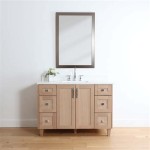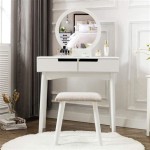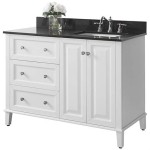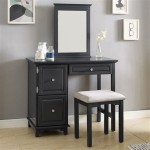Exploring the Versatility of a 36-Inch Wood Vanity with Top
A 36-inch wood vanity with top represents a practical and aesthetically pleasing solution for bathroom renovations, powder room upgrades, or new construction projects. Its size provides a balance between ample storage and space efficiency, making it suitable for a wide range of bathroom layouts. The inclusion of a top, whether it be natural stone, quartz, ceramic, or another material, offers a cohesive and ready-to-install unit, simplifying the installation process and ensuring a consistent design aesthetic.
The appeal of a 36-inch wood vanity lies in its adaptability. It can seamlessly integrate into traditional, modern, or transitional bathroom designs, depending on the wood finish, style of the cabinet doors and drawers, and the material and color of the countertop. Furthermore, the availability of various sink configurations, including single bowl, undermount, or vessel sinks, allows for customization based on individual preferences and functional requirements.
This article will delve into the key considerations when selecting a 36-inch wood vanity with a top, exploring the different material options, design styles, and functional features that contribute to its overall value and suitability for a particular bathroom space.
Wood Types and Finishes: Defining Durability and Style
The selection of wood for a vanity cabinet significantly impacts its longevity and aesthetic appeal. Solid wood, plywood, and MDF (Medium Density Fiberboard) are common materials used in vanity construction, each offering distinct advantages and disadvantages.
Solid wood, such as oak, maple, cherry, or birch, is prized for its natural beauty, durability, and resistance to moisture. However, solid wood is typically more expensive and can be susceptible to warping or cracking if not properly sealed and maintained. Proper sealing involves the application of multiple coats of polyurethane or other water-resistant finishes.
Plywood, composed of multiple layers of wood veneer glued together, offers a stable and durable alternative to solid wood. High-quality plywood is less prone to warping and cracking, making it a suitable choice for bathroom environments. It is often used for the vanity's frame and side panels.
MDF, a composite material made from wood fibers and resin, is a cost-effective option that provides a smooth and uniform surface for painting or laminating. While MDF is less resistant to moisture than solid wood or plywood, it can be treated with moisture-resistant coatings to enhance its durability. It is commonly used for cabinet doors and drawer fronts.
The finish applied to the wood plays a crucial role in protecting it from moisture and enhancing its aesthetic appeal. Common finishes include painted finishes, stained finishes, and laminate finishes. Painted finishes offer a wide range of color options and can be easily updated to match changing design trends. Stained finishes highlight the natural grain of the wood and add warmth and character to the vanity. Laminate finishes provide a durable and easy-to-clean surface that is resistant to scratches and stains.
The choice of wood type and finish should be based on factors such as budget, desired aesthetic, and anticipated level of use and exposure to moisture. Selecting high-quality materials and finishes will ensure the longevity and beauty of the vanity for years to come.
Countertop Materials: Balancing Aesthetics and Functionality
The countertop is a focal point of the vanity and plays a critical role in its overall functionality and aesthetic appeal. Common countertop materials include natural stone (granite, marble), engineered stone (quartz), solid surface materials, ceramic tile, and laminate.
Granite is a natural stone known for its durability, heat resistance, and unique patterns. It is relatively resistant to scratches and stains but requires sealing to prevent absorption of liquids and potential staining. The variations in color and veining make each granite countertop unique.
Marble is a luxurious natural stone prized for its elegant appearance and smooth surface. However, marble is more porous than granite and is susceptible to staining and etching from acidic substances. It requires careful sealing and maintenance to preserve its beauty.
Quartz is an engineered stone made from crushed quartz crystals and resin. It offers a consistent color and pattern, lower maintenance requirements and is more resistant to scratches, stains, and heat than natural stone. Quartz is a popular choice for modern bathrooms.
Solid surface materials, such as Corian, are non-porous, seamless, and renewable. They are resistant to stains, scratches, and bacteria, making them a hygienic and easy-to-maintain option. Solid surface materials can be molded into various shapes and sizes, offering design flexibility.
Ceramic tile is a versatile and cost-effective option that offers a wide range of colors, patterns, and textures. It is resistant to water and stains but requires grout sealing to prevent moisture penetration. Tile countertops can be customized with decorative accents and borders.
Laminate is a budget-friendly option that consists of a plastic layer bonded to a particleboard core. It is available in a variety of colors and patterns and is relatively easy to clean. However, laminate is susceptible to scratches and damage from heat and moisture.
The selection of countertop material should be based on factors such as budget, desired aesthetic, maintenance requirements, and anticipated level of use. Considering the pros and cons of each material will help in choosing the best option for a particular bathroom space.
Storage Solutions and Design Styles: Maximizing Functionality and Space
A 36-inch wood vanity offers various storage options to accommodate toiletries, towels, and other bathroom essentials. The design of the cabinet doors, drawers, and shelves significantly impacts the functionality and usability of the vanity.
Vanities with drawers provide convenient storage for smaller items, such as makeup, toiletries, and grooming tools. Drawers can be configured in various sizes and depths to accommodate different storage needs. Soft-close drawer mechanisms enhance the user experience by preventing slamming and minimizing noise.
Cabinets with doors offer ample storage for larger items, such as towels, cleaning supplies, and extra toiletries. Adjustable shelves allow for customization of the storage space. Some vanities feature a combination of drawers and cabinets to provide a versatile storage solution.
Open shelving provides a stylish and accessible storage option for displaying decorative items or frequently used toiletries. Open shelves can be incorporated into the vanity design to complement the closed storage options.
The design style of the vanity should complement the overall aesthetic of the bathroom. Common design styles include traditional, modern, transitional, and farmhouse.
Traditional vanities often feature ornate detailing, raised panel doors, and antique-inspired hardware. They are typically made from dark wood finishes, such as cherry or mahogany. Traditional vanities create a classic and elegant look.
Modern vanities feature clean lines, minimalist design, and sleek hardware. They are often made from light wood finishes or painted in neutral colors, such as white, gray, or black. Modern vanities create a contemporary and sophisticated look.
Transitional vanities blend elements of traditional and modern design. They feature simple lines, versatile hardware, and a mix of wood finishes and painted surfaces. Transitional vanities offer a balanced and timeless look.
Farmhouse vanities feature rustic details, shiplap panels, and vintage-inspired hardware. They are often made from distressed wood finishes or painted in muted colors, such as cream, sage green, or light blue. Farmhouse vanities create a cozy and inviting look.
The choice of storage solutions and design style should be based on individual needs, preferences, and the overall aesthetic of the bathroom. Selecting a vanity that maximizes functionality and complements the existing decor will enhance the overall value and enjoyment of the bathroom space.
Furthermore, consider the plumbing configuration when selecting a vanity. Ensure that the vanity is compatible with the existing plumbing fixtures, including the water supply lines and drainpipe. If necessary, consult with a plumber to determine the appropriate vanity size and configuration for the bathroom.
In conclusion, a 36-inch wood vanity with a top provides a versatile and practical solution for bathroom renovations and upgrades. Careful consideration of the wood type, finish, countertop material, storage solutions, and design style will ensure that the selected vanity meets individual needs, complements the overall aesthetic of the bathroom, and provides years of reliable use.

Allen Roth Harwood 36 In Natural Undermount Single Sink Bathroom Vanity With White And Gray Quartz Top At Com

Solid Wood 36 Inch Vanities Bathroom With Tops The Home

Angeles Home 36 In W X 22 D 35 H Certified Single Sink Solid Wood Bath Vanity Oak With White Quartz Top Soft Close Drawers Kylan368ck The

36 Inch Vanities Bathroom The Home

Gavino 36 Wood Vanity In Light Brown With Composite Stone Top No Mirror Homesquare

Cerrito 36 Wood Vanity In Nature Oak Engineered Stone Top No Mirror Wal Com

36 Wood Floating Vanity Offset Single Sink What We Make

Adelina 36 Inch All Wood Construction Vessel Sink Bathroom Vanity Imperial White Marble Counter Top

Supreme Wood 36 Inch Vanities Bathroom With Tops The Home

Altair Gavino 36 Wood Vanity In Light Brown With Composite Stone Top No Mirror







